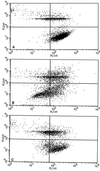Regulation of expression of major histocompatibility antigens by bovine macrophages infected with Mycobacterium avium subsp. paratuberculosis or Mycobacterium avium subsp. avium
- PMID: 11159996
- PMCID: PMC97980
- DOI: 10.1128/IAI.69.2.1002-1008.2001
Regulation of expression of major histocompatibility antigens by bovine macrophages infected with Mycobacterium avium subsp. paratuberculosis or Mycobacterium avium subsp. avium
Abstract
Mycobacterium avium subsp. paratuberculosis and Mycobacterium avium subsp. avium are antigenically and genetically very similar organisms; however, they differ markedly in their virulence for cattle. We evaluated the capacity of bovine macrophages infected with M. avium subsp. paratuberculosis or M. avium subsp. avium to express major histocompatibility complex (MHC) class I and class II antigens on their surface and to interact with primed autologous lymphocytes. Our results indicate that infection of bovine macrophages with M. avium subsp. paratuberculosis promoted the downregulation of MHC class I and class II molecules on the macrophage surface within 24 and 12 h, respectively. Alternatively, MHC class II expression by M. avium subsp. avium-infected macrophages was not detected until 24 h after infection, and the magnitude of the decrease was smaller. Decreased MHC class I expression by M. avium subsp. avium-infected macrophages was not detected. Unlike M. avium subsp. paratuberculosis-infected macrophages, M. avium subsp. avium-infected macrophages upregulated MHC class I and class II expression after activation by gamma interferon or tumor necrosis factor alpha. Further, M. avium subsp. avium-infected macrophages were lysed by primed autologous lymphocytes, whereas M. avium subsp. paratuberculosis-infected macrophages were not. Overall, the results support the hypothesis that the difference in the virulence of M. avium subsp. paratuberculosis and M. avium subsp. avium for cattle is dependent on a difference in the capacity of the organisms to suppress mycobacterial antigen presentation to T lymphocytes.
Figures







References
-
- Antoine J C, Prima E, Lang T, Courret N. The biogenesis and properties of the parasitophorous vacuoles that harbor Leishmania in murine macrophages. Trends Microbiol. 1998;6:392–401. - PubMed
-
- Antoine J C, Lang T, Prima E, Courret N, Hellio R. H-2M molecules, like MHC class II molecules, are targeted to parasitophorous vacuoles of Leishmania-infected macrophages and internalized by amastigotes of L. amazonensis and L. mexicana. J Cell Sci. 1999;112:2559–2570. - PubMed
-
- Bonecini-Almeida M G, Chitale S, Boutsikakis I, Geng J, Doo H, He S, Ho J L. Induction of in vitro human macrophage anti-Mycobacterium tuberculosis activity: requirement for INF-γ and primed lymphocytes. J Immunol. 1998;160:4490–4499. - PubMed
-
- Brennan P L, Nikaido H. The envelope of mycobacteria. Annu Rev Biochem. 1995;64:29–63. - PubMed
Publication types
MeSH terms
Substances
LinkOut - more resources
Full Text Sources
Research Materials

